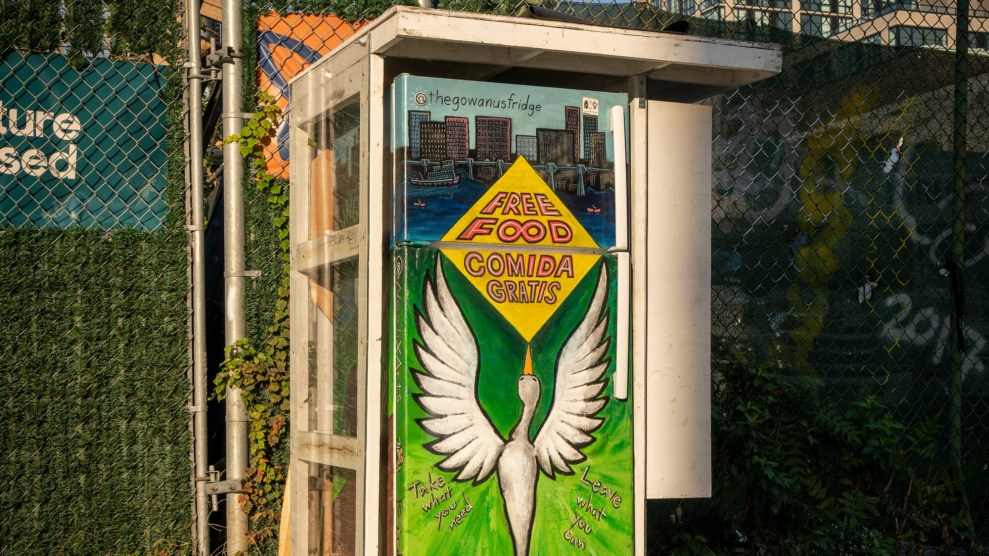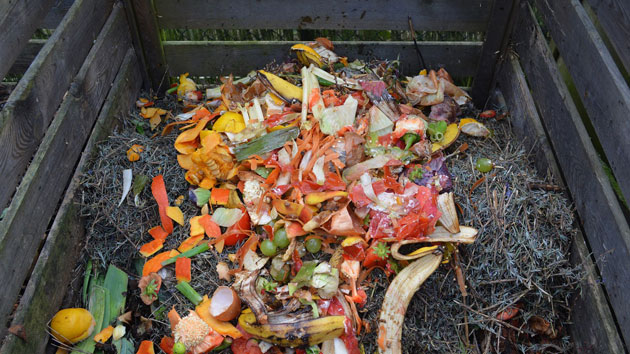
A free food refrigerator in the Gowanus neighborhood in Brooklyn.Richard B. Levine / ZUMA
This story was originally published by Grist and is reproduced here as part of the Climate Desk collaboration.
Dan Zauderer and his in-laws had eaten plenty of pizza one evening in early October, and they still had seven slices left. What to do? “Well, we could just chuck it,” Zauderer thought. Instead, he and his fiancée wrapped the slices in plastic wrap, slapped labels on them with the date, and walked the leftovers a little more than a block down the road to a refrigerator standing along 92nd Avenue in New York City’s Upper East Side.
That fridge is one among many “community fridges” across the country that volunteers stock with free food—prepared meals, leftovers, and you name it. Zauderer had helped set a network up in New York City during the pandemic as a way to reduce waste and fight hunger. The idea came about when he was a middle school teacher looking to provide short-term help to students whose families couldn’t afford food. He stationed the first fridge in the Bronx in September 2020. That one, the Mott Haven Fridge, was hugely popular, and it motivated Zauderer to expand. Since then, he has helped plug in seven more fridges in the Bronx and Manhattan, including the one where he dropped off his leftover pizza.
“It just blossomed into way more than I ever could have expected,” said Zauderer, who now works full-time at Grassroots Grocery, a food-distribution nonprofit he co-founded in New York.
It’s not just Zauderer’s project that has blossomed. Community fridges first cropped up a decade ago in a few isolated spots around the globe, then spread across the United States right after the pandemic started in 2020, when supply chains were crumbling, food prices were rising, and families across the country were struggling to find meals. At the time, the fridges were viewed as a creative response to an urgent need. But when the pandemic subsided, it became clear that the refrigerators — sometimes called freedges, friendly fridges, and love fridges — were more than a fad. Today, nonprofits and mutual aid groups are overseeing hundreds of fridges that bolster access to food in cities from Miami to Anchorage, Alaska.
The fridges also embody a straightforward solution to climate change. Each year, tens of billions of pounds of food, more than a third of what’s produced in the U.S., get tossed into trash bins. Most of those scraps end up in landfills, where they decompose and release methane, a powerful heat-trapping gas. The sheer quantity of the country’s combined waste makes it a major source of climate pollution: Food waste accounts for as much as 10 percent of global greenhouse gas emissions. And more food is being thrown out than ever.
“There’s no solution to our climate problem that doesn’t also address food waste,” said Emily Broad Leib, director of the Harvard Food Law and Policy Clinic.
There are many ways to keep food out of landfills and on dinner tables. Companies are developing apps to connect people with donated goods, and food banks have been around for decades. Experts say raising awareness and changing policy around things like expiration dates on food packaging, which can be arbitrary, would help, too. But fridges are especially effective when other solutions fall short. Though food banks are great for storing large amounts of shelf-stable items like canned vegetables, they’re not well-equipped to handle food that doesn’t last as long and turns up in small amounts—a pizza slice here, a sandwich there. Those remnants make up much of the country’s food waste, about 40 percent, and that’s where community fridges excel. “These are just a really elegant solution to that,” Broad Leib said.
The fridges also offer a degree of anonymity for those in need that’s hard to find at more traditional food distribution centers, like food pantries. People don’t have to sign up or prove their eligibility to use them. “The whole point is dignified, anonymous access,” Zauderer said. “We’re not the arbiters of how much to take.”
In Chicago, an artist named Eric Von Haynes co-founded a fridge network called The Love Fridge in 2020. Today, he helps oversee more than 20 love fridges, each decorated with eye-popping colors and phrases like “Free food for all!” According to Von Haynes, the fridges are filled, cleaned, and maintained by hundreds of volunteers. He estimates that thousands of pounds of food move through them each month.
One concern that researchers have with projects that repurpose food is that they require additional resources, like transportation and electricity. “Rescuing [food] still comes at a cost,” said Kathryn Bender, a professor and food waste researcher at the University of Delaware.
But community fridges are about as low-key and energy efficient as solutions get. Zauderer didn’t burn any fossil fuels to walk his pizza to the fridge near his apartment. And the Love Fridge, which acquires only used refrigerators, powers two of them with solar panels—a vision that Von Haynes has for more to come.
Even a fridge that draws electricity from a coal-powered grid uses less energy each day than a single cell phone, said Dawn King, who researches food waste and policy at Brown University. “Is it worth using greenhouse gas emissions to plug in a refrigerator so people can eat food that otherwise would have gotten wasted? Hell yes it is.”
Other challenges include navigating concerns about rotten or unwanted food, making sure fridges are working properly, especially during increasingly hot summers, and keeping them stocked. Ernst Bertone Oehninger, who helped set up what may have been the first “freedge” in the U.S. in 2014 in Davis, California, has learned that some items don’t belong in them.
“Think about a half-eaten burger. That’s a no-go,” said Oehninger. “But this is very rare. Most people bring good leftovers.” Like Zauderer’s pizza.
A fridge in Austin, Texas, once went missing. It had been “borrowed” by someone who wanted to keep beers cold for an event at South by Southwest, according to Kellie Stiewert, an organizer at the ATX Free Fridge project. But such shenanigans are rare. That the fridges can be placed with a property owner’s permission just about anywhere—in front of a taqueria, a person’s home, an office building—is what makes the concept “beautiful,” Stiewert said.
Organizers say keeping the fridges full is one of the toughest tasks. People sometimes gather to pick up items within minutes of a fridge getting stocked. “When I first get volunteers to do food distro with me, I’m always waiting for them to recognize how fast the food goes,” Von Haynes said. “It’s really hard to explain to people.”
As for Zauderer’s pizza slices: “They definitely weren’t there the next day.”











